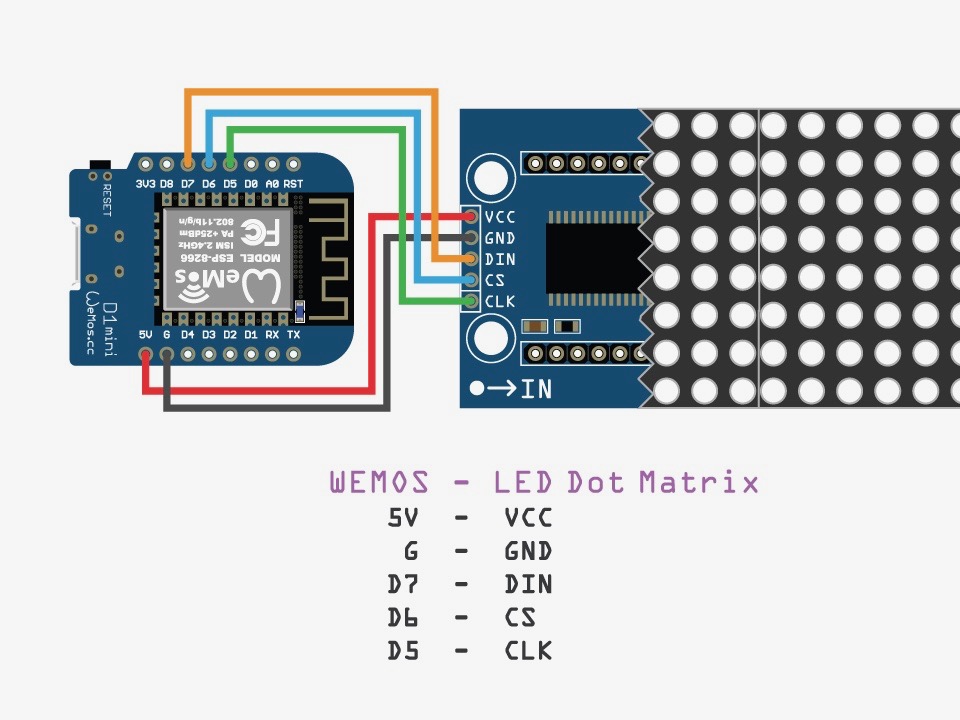Make your own IoT smart clock that can:
- Display clock with a beautiful animation icon
- Display reminder-1 to reminder-5
- Display calendar
- Display Muslim prayer times
- Display weather information
- Display news
- Display advice
- Display Bitcoin rate
- Display Hackster/Instructables followers and view counts
- Display YouTube subscribers (real-time) and view counts
Easy to build just need a Wemos D1 Mini and MAX7219 LED Dot Matrix Panel. No need programming skill no need Laptop/PC to program Wemos ESP8266 microcontroller, just need Android phone to upload sketch/firmware to Wemos via USB OTG.
It runs completely autonomously and be configured and controlled via an Android app, with the app you can configure and setting IoT Smart Clock (ESP Matrix) device very easy with a simple interface.
Step 1: Things NeededHere are the things that you will need to make ESP Matrix:
- Wemos D1 Mini - ESP8266
- MAX7219 LED Dot Matrix Panel
- Dupont cable - Included in LED Dot Matrix Panel
- OTG Adapter
- Micro USB cable
- 3D-Printed Case
- Pieces of transparent colored Acrylic 129x32x3mm
- Android phone (Installed ESP Matrix app)
1) Remove the LED Dot matrix component in the first column that have the soldered header pin on pcb.
2) Twisted all male pin headers 180° using long-nose pliers, so that they point inward.
Step 3: Wiring1) Cut half of the existing dupont cable, so it becomes around 10cm.
2) Connect female header on dupont cable with male header on LED Dot matrix panel, see picture.
3) Separate the cable into two parts, 2 cables for VCC & GND, 3 cables for CLK DS & DIN. then enter into the hole on the pcb, see picture.
Step 4: Before Soldering1) Peel the end of the cable using a wire stripper tools.
2) Then cover all ends of the cable with tin.
Step 5: Soldering1) Solder to connect CLK to D5, CS to D6 & DIN to D7.
2) Solder to connect VCC to 5V & GND to G.
Step 6: Putting It All TogetherYou can use double sided tape, to glue between the Wemos and the LED Dot matrix panel, see the picture. Also reinstall the LED Dot matrix component which is in first step removed
Step 7: Placing to the 3D-Printed CaseThis 3D-printed case is design more slim and pressing to make it look solid and robust, so to install it is not so easy need a little pressed.
ESP matrix can be made in two sizes, a short 32x8 pixel of LED use 1 panel LED Dot matrix and a long 64x8 pixels of LED use 2 panel LED dot matrix, so to make a 3D-printed case depends on your choice.
Step 8: Add AcrylicTo make the light of the LEDs be more clear and diffused, on the LED surface add black transparent colored acrylic.
There are two sizes of acrylic:
- A short: 129x32x3mm.
- A long: 257x32x3mm
1) To program the Wemos ESP8266 (ESP Matrix) very simple, you only need to connect Wemos (ESP Matrix) to an Android phone via a micro usb cable and OTG adapter, see picture.
2) Then install the ESP Matrix app from Google Playstore. https://goo.gl/b9YAth
3) In the first welcome screen tap UPLOAD button.
Step 10: App Interface for ConfigurationAfter programming is complete then it is necessary to set some parameters of the devices:
1) Connect ESP Matrix device to network internet using app.
2) You need Sign-up to get an API key from openweathermap.org, then copy the your API key to the weather option in app.
3) You need City ID from openweathermap.org, eg.2643743 for London, then copy the your City ID to the weather option in app.
Step 11: Make a Long Type 64x8If you feel dissatisfied with the short type because you can only see short messages, so you can make the long type the length of the size two times longer. For more details you can follow the tutorial in this video.
Step 12: EnjoyHopefully you enjoy your ESP Matrix. If you do, please share your makes, share the link, like and subscribe. As always, if you have any questions please let me know!









Comments
Please log in or sign up to comment.